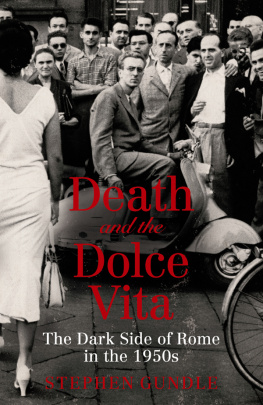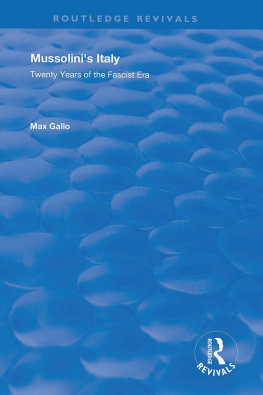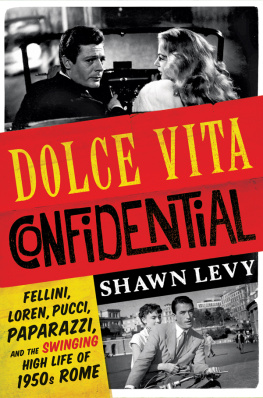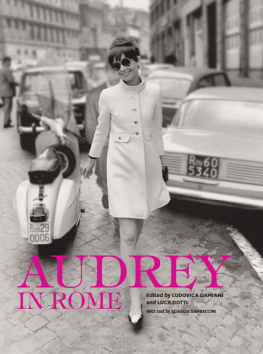DEATH AND THE DOLCE VITA
Also by Stephen Gundle
Between Hollywood and Moscow: The Italian Communists and the Challenge of Mass Culture
The Glamour System (with Clino Castelli)
Bellissima: Feminine Beauty and the Idea of Italy
Mass Culture and Italian Society from Fascism to the Cold War (with David Forgacs)
Glamour: A History
DEATH AND THE DOLCE VITA
THE DARK SIDE OF ROME IN THE 1950S
STEPHEN GUNDLE

First published in Great Britain in 2011 by Canongate Books Ltd, 14 High Street, Edinburgh EH1 1TE
Copyright Stephen Gundle, 2011
The moral right of the author has been asserted
Every effort has been made to trace copyright holders and obtain permission for the use of copyright material. The publisher apologises for any errors or omissions and would be grateful if notified of any corrections that should be incorporated into future reprints or editions of this book.
British Library Cataloguing-in-Publication Data
A catalogue record for this book is available on
request from the British Library
ISBN 978 1 84767 654 2
Export ISBN 978 1 84767 929 1
eISBN 978 0 85786 049 1
Typeset in Bembo by Palimpsest Book Production Ltd,
Falkirk, Stirlingshire
www.canongate.tv
To the memory of my father
Arthur Gundle (19251971)
and for my son Alessandro
Dramatis Personae
THE MONTESI FAMILY CIRCLE
Rodolfo, Wilmas father, a carpenter and family man
Maria (ne Petti), Rodolfos wife and Wilmas mother
Wanda, first child of Rodolfo and Maria
Wilma, second child of Rodolfo and Maria
Sergio, third child of Rodolfo and Maria
Giuseppe (also known as Peppe or Peppino), Rodolfos brother and Wilmas uncle
Angelo Giuliani, a policeman from Foggia and Wilmas fianc
Mariella Spissu, Giuseppes fiance
Rossana Spissu, sister of Mariella and Giuseppes lover
PERSONALITIES OF THE CASE
Adriana Bisaccia, artists model and Bohemian dropout
Anna Maria Moneta Caglio, socialite, aspiring actress and Ugo Montagnas lover
Ugo Montagna, Marchese di San Bartolomeo, a Sicilian with extensive business contacts in Rome and a lessee of the Capacotta hunting estate
Rosa Passarelli, Ministry of Defence employee who claimed to see Wilma on the train to Ostia
Piero Piccioni, jazz musician and son of government minister Attilio
LEGAL OFFICIALS, POLICE AND LAWYERS
Tommaso Pavone, national chief of police
Saverio Polito, police commissioner for Rome
Umberto Pompei, commandant of the Rome division of the Carabinieri, the national gendarmerie
Raffaele Sepe, head of the investigative division of the Court of Appeal
Giuseppe Sotgiu, Communist president of the Province of Rome; defence attorney of Silvano Muto
Cosimo Zinza, Carabinieri lieutenant and assistant to Raffaele Sepe
THE POLITICAL WORLD
Giulio Andreotti, Rome-born associate of De Gasperi; minister for the interior, JanuaryMarch 1954
Alcide De Gasperi, founder and leader of the Christian Democrats; prime minister, December 1945August 1953
Amintore Fanfani, Christian Democrat, leader of the partys left wing; minister for the interior, July 1953January 1954
Attilio Piccioni, deputy leader of the Christian Democrats; foreign minister, December 1953August 1954, and father of Piero
Mario Scelba, Sicilian Christian Democrat; minister for the interior, May 1947July 1953; prime minister, January 1954July 1955
Giuseppe Spataro, Christian Democrat; minister of posts, January 1950July 1953
THE PRESS
Luciano Doddoli, reporter, Il Giorno; correspondent, Epoca
Fabrizio Menghini, chief crime reporter, Il Messaggero
Silvano Muto, journalist and founder of Attualit
Tazio Secchiaroli, press photographer, the first paparazzo
THE ARTS AND ENTERTAINMENT
Linda Christian, actress and socialite, married actor Tyrone Power in Rome in 1949
Anita Ekberg, Swedish film star and queen of the Roman night scene in 1958.
Federico Fellini, director of the Rome-set films Nights of Calabria, Il bidone and La dolce vita
Novella Parigini, artist from Via Margutta and socialite
Gi Stajano, artist and provocateur, friend of Novella Parigini
Alida Valli, star of Italian Fascist cinema, who went to Hollywood in 1947 and returned to Italy in 1952. Lover of Piero Piccioni
Prologue
Rome
9 April 1953
I ts a blustery spring afternoon on the Via Tagliamento, a busy residential road to the east of the city. Bicycles trundle by, while Vespas and Lambrettas occasionally zip up and down the street, manoeuvring around the slower cars and trucks. Its cold, and a light drizzle has left the pavement wet. People are wearing their winter coats to visit the local shops, which have just opened for the afternoon trade. Pedestrians hurry along, eager to get out of the wind. Halfway along the road, opposite no. 76, an imposing apartment building with a decorative faade, a group of workmen lean on their shovels, smoking and eyeing up the passing talent. Its an ordinary day in a romantic, slightly shabby city, where church bells still drown the loudspeakers of the advertising vans, and the glitz and the gutter are never too far apart.
At around five fifteen p.m., a young woman leaves her familys modest apartment upstairs in no. 76. Shes twentyone, dark-haired and pretty, with a full face and dimpled cheeks. Shes wearing a distinctive yellow and green checked coat, with one button at the collar, a yellow skirt with green spots, and a pair of black antelope shoes with large buckles. On her arm she carries a bucket handbag. She makes her way down the stairwell, walks across the blocks courtyard and passes through the entrance arch. The concierge sees the young woman pass her window, but after she goes out onto the street, the only people who notice her are the idle workmen, who whistle appreciatively.
When she fails to return for dinner that evening, her family panic. After making some urgent phone calls to relatives, and searching the immediate neighbourhood, they report her disappearance to the police.
Thirty-six hours later, a body is found on a beach some twenty kilometres south of Ostia at Torvaianica. Discovered early in the morning by a young man named Francesco Bettini, the woman is lying face down, head towards the sea. She is dressed in a yellow coat, still fastened at the neck, but turned inside out over her head. The body is fully clothed, apart from shoes, skirt, stockings and suspender belt. Shocked, Bettini hurries off to inform the police, telling everyone he meets along the way about his discovery.Villagers come to stare and are pushed away by local officials belonging to one of Italys six national police forces, the Financial Police, who arrive to inspect the body. No one can give her a name.
Next page











